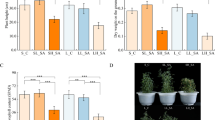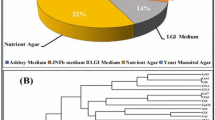Abstract
In order to determine the underlying mechanism of the senescence occurring in older apple trees, the effects of tree age on the community structure and dominant genus of endophytic rhizosphere bacteria in apple were investigated. The diversity and structure of the bacterial communities and corresponding changes in the dominant genera of endophytic rhizosphere bacteria of apple at different ages (2, 8, 16, 22 years) were compared based on 16S rRNA high-throughput sequencing technology. The results revealed that the longer the tree age, the less the number of ASV in the endophytic bacteria. Moreover, the number of ASV in the endophytic bacteria gradually decreased as the tree age increased, however no significant changes were observed in the alpha diversity. At the phyla level, the relative abundance of Actinobacteria increased, while that of Proteobateria decreased. At the genus level, the relative abundance of Mycobacterium, Chujaibacter, and other genera increased, while the relative abundance of Aquabacterium, Ralstonia, Streptomyces, Asticcacaulis, Hyphomicrobium, Pseudomonas, and Sphingomonas decreased. The reduced relative abundance of endophytic rhizosphere bacteria associated with plant growth and disease resistance may thus be the cause of tree senescence. This work acts as a reference to increases the understanding of plant–microbe interactions.







Similar content being viewed by others
References
Edwards, J., Johnson, C., Santos-Medellín, C., Lurie, E., Podishetty, N. K., Bhatnagar, S., et al. (2015). Structure, variation, and assembly of the root-associated microbiomes of rice. Proceedings of the National Academy of Sciences of the United States of America., 112(8), E911–E920. https://doi.org/10.1073/pnas.1414592112
Berendsen, R. L., Pieterse, C. M., & Bakker, P. A. (2012). The rhizosphere microbiome and plant health. Trends in Plant Science., 17(8), 478–486. https://doi.org/10.1016/j.tplants.2012.04.001
Berlec, A. (2012). ovel techniques and findings in the study of plant microbiota: Search for plant probiotics. Plant Science., 193–194, 96–102. https://doi.org/10.1016/j.plantsci.2012.05.010
Schlaeppi, K., & Bulgarelli, D. (2015). The plant microbiome at work. Molecular Plant-Microbe Interactions., 28, 212–217. https://doi.org/10.1094/MPMI-10-14-0334-FI
Ryan, R. P., Germaine, K., Franks, A., Ryan, D. J., & Dowling, D. N. (2008). Bacterial endophytes: Recent developments and applications. FEMS Microbiology Letters, 278(1), 1–9. https://doi.org/10.1111/j.1574-6968.2007.00918.x
Bian, X., Xiao, S., Zhao, Y., Xu, Y., Yang, H., & Zhang, L. (2020). Comparative analysis of rhizosphere soil physiochemical characteristics and microbial communities between rusty and healthy ginseng root. Scientific Reports, 10(1), 15756. https://doi.org/10.1038/s41598-020-71024-8
Garbeva, P., Hordijk, C., Gerards, S., & de Boer, W. (2014). Volatile-mediated interactions between phylogenetically different soil bacteria. Frontiers in Microbiology, 5(289), 289. https://doi.org/10.3389/fmicb.2014.00289
De Oliveira, A. J., Franco, T. C., Florentino, L. A., & Correa Landgraf, P. R. (2020). Characterization of associative diazotrophic bacteria in torch ginger. The Journal SeminaCienciasAgrarias, 41(6), 2815–2823. https://doi.org/10.5433/1679-0359.2020v41n6p2815
Geries, L. S. M., & Elsadany, A. Y. (2021). Maximizing growth and productivity of onion (Allium cepa L.) by Spirulina platensis extract and nitrogen-fixing endophyte Pseudomonas stutzeri. Archives of Microbiology, 203(1), 169–181. https://doi.org/10.1007/s00203-020-01991-z
Afzal, I., Shinwari, Z. K., Sikandar, S., & Shahzad, S. (2019). Plant beneficial endophytic bacteria: Mechanisms, diversity, host range and genetic determinants. Microbiological Research, 221(2019), 36–49. https://doi.org/10.1016/j.micres.2019.02.001
Marchesi, J. R., & Ravel, J. (2015). The vocabulary of microbiome research: a proposal. Microbiome, 3, 31. https://doi.org/10.1186/s40168-015-0094-5
Benitez, M. S., Osborne, S. L., & Lehman, R. M. (2017). Previous crop and rotation history effects on maize seedling health and associated rhizosphere microbiome. Scientific Reports, 7(1), 15709. https://doi.org/10.1038/s41598-017-15955-9
Xu, L., Naylor, D., Dong, Z., Simmons, T., Pierroz, G., Hixson, K. K., et al. (2018). Drought delays development of the sorghum root microbiome and enriches for monoderm bacteria. Proceedings of the National Academy of Sciences, 115(18), E4284–E4293. https://doi.org/10.1073/pnas.1717308115
Cordero, J., de Freitas, J. R., & Germida, J. J. (2020). Bacterial microbiome associated with the rhizosphere and root interior of crops in Saskatchewan, Canada. Canadian Journal of Microbiology., 66(1), 71–85. https://doi.org/10.1139/cjm-2019-0330
Pang, Z., Xu, P., & Yu, D. (2020). Environmental adaptation of the root microbiome in two rice ecotypes. Microbiological Research, 241, 126588. https://doi.org/10.1016/j.micres.2020.126588
Liu, J., Ridgway, H. J., & Jones, E. E. (2020). Apple endophyte community is shaped by tissue type, cultivar and site and has members with biocontrol potential against Neonectriaditissima. Journal of Applied Microbiology., 128(6), 1735–1753. https://doi.org/10.1111/jam.14587
Grinbergs, D., Chilian, J., Padilla, N., Reyes, M., France, A., Moya-Elizondo, E., & Gerding, M. (2021). Endophytic microorganisms associated with reversion of silverleaf disease symptoms in apple. Phytopathology, 111(9), 1541–1550. https://doi.org/10.1094/PHYTO-12-20-0548-R
Rho, H., Van Epps, V., Kim, S. H., & Doty, S. L. (2020). Endophytes increased fruit quality with higher soluble sugar production in honeycrisp apple (Malus pumila). Microorganisms., 8(5), 699. https://doi.org/10.3390/microorganisms8050699
Berdeni, D., Cotton, T. E. A., Daniell, T. J., Bidartondo, M. I., Cameron, D. D., & Evans, K. L. (2018). The effects of arbuscular mycorrhizal fungal colonisation on nutrient status, growth, productivity, and canker resistance of apple (Malus pumila). Frontiers in Cellular and Infection Microbiology., 3(9), 1461. https://doi.org/10.3389/fmicb.2018.01461
Wang, Q., Sun, H., Li, M., Xu, C., & Zhang, Y. (2020). Different age-induced changes in rhizosphere microbial composition and function of Panax ginseng in transplantation mode. Frontiers in Plant Science, 11, 563240. https://doi.org/10.3389/fpls.2020.563240
Bolyen, E., Rideout, J. R., Dillon, M. R., Bokulich, N. A., Abnet, C. C., et al. (2019). Reproducible, interactive, scalable and extensible microbiome data science using QIIME 2. Nature Biotechnology, 37(8), 852–857. https://doi.org/10.1038/s41587-019-0209-9
Callahan, B. J., Mcmurdie, P. J., Rosen, M. J., Han, A. W., Johnson, A. J., & Holmes, S. P. (2016). Dada2: High-resolution sample inference from Illumina amplicon data. Nature Methods., 13(7), 581–583. https://doi.org/10.1038/nmeth.3869
Quast, C., Pruesse, E., Yilmaz, P., Gerken, J., Schweer, T., Yarza, P., Peplies, J., & Gloeckner, F. O. (2012). The SILVA ribosomal RNA gene database project: Improved data processing and web-based tools. Nucleic Acids Research, 41, D590-596. https://doi.org/10.1093/nar/gks1219
Vandenkoornhuyse, P., Quaiser, A., de Duhamel, M., Van, A., & Dufresne, A. (2015). The importance of the microbiome of the plant holobiont. New Phytologist, 206(4), 1196–1206. https://doi.org/10.1111/nph.13312
Andreolli, M., Lampis, S., Zapparoli, G., Angelini, E., & Vallini, G. (2016). Diversity of bacterial endophytes in 3 and15 year-old grapevines of Vitis vinifera cv. Corvina and their potential for plant growth promotion and phytopathogen control. Microbiological Research., 183, 42–52. https://doi.org/10.1016/j.micres.2015.11.009
Miguel, P. S., de Oliveira, M. N., Delvaux, J. C., de Jsus, G. L., Borges, A. C., Tótola, M. R., Neves, J. C., & Costa, M. D. (2016). Diversity and distribution of the endophytic bacterial community at different stages of eucalyptus growth. Antonie Van Leeuwenhoek, 109(6), 755–771. https://doi.org/10.1007/s10482-016-0676-7
Distelbarth, H., Kull, U., & Jeremias, K. (1984). Seasonal trends in energy contents of storage substances in evergreen gymnosperms growing under mild climatic conditions in Central Europe. Flora, 109(6), 755–771. https://doi.org/10.18419/opus-2238
Li, C., Li, X., Kong, W., Wu, Y., & Wang, J. (2010). Effect of monoculture soybean on soil microbial community in the Northeast China. Plant and Soil, 330, 423–433. https://doi.org/10.1007/s11104-009-0216-6
Bulgari, D., Bozkurt, A. I., Casati, P., Cağlayan, K., Quaglino, F., & Bianco, P. A. (2012). Endophytic bacterial community living in roots of healthy and ’Candidatus Phytoplasma mali’-infected apple (Malus domestica, Borkh.) trees. Antonie Van Leeuwenhoek, 102(4), 677–87. https://doi.org/10.1007/s10482-012-9766-3
Liu, Y., Wang, R., Li, Y., Cao, Y., Chen, C., Qiu, C., et al. (2017). High-throughput sequencing-based analysis of the composition and diversity of endophytic bacterial community in seeds of “Beijing” hybrid maize planted in China. Plant Growth Regulation, 81, 317–324. https://doi.org/10.1007/s10725-016-0208-5
Wang, Y., Xu, X., Liu, T., Wang, H., Yang, Y., Chen, X., & Zhu, S. (2020). Analysis of bacterial and fungal communities in continuous-cropping ramie (Boehmeria nivea L. Gaud) fields in different areas in China. Scientific Reports, 10(1), 3264. https://doi.org/10.1038/s41598-020-58608-0
Kanokratana, P., Uengwetwanit, T., Rattanachomsri, U., Bunterngsook, B., Nimchua, T., Tangphatsornruang, S., et al. (2011). Insights into the phylogeny and metabolic potential of a primary tropical peat swamp forest microbial community by metagenomic analysis. Microbial Ecology., 61(3), 518–528. https://doi.org/10.1007/s00248-010-9766-7
Chen, S., Dai, J., Song, X., Jiang, X., & Han, B. (2019). Endophytic microbiota comparison of dendrobium huoshanense root and stem in different growth years. Planta Medica, 86(13–14), 967–975. https://doi.org/10.1055/a-1046-1022
Scott, M., Rani, M., Samsatly, J., Charron, J.-B., & Jabaji, S. (2018). Endophytes of industrial hemp (Cannabis sativa L.) cultivars: identification of culturable bacteria and fungi in leaves, petioles, and seeds. Canadian Journal of Chemistry, 64(10), 664–680. https://doi.org/10.1139/cjm-2018-0108
Brenda, R.-P., Reza-Vázquez, D. M., Gutiérrez-Paredes, S., et al. (2017). Plant growth-promoting traits in rhizobacteria of heavy metal-resistant plants and their effects on Brassica nigra seed germination. Pedosphere, 27(3), 511–526. https://doi.org/10.1016/s1002-0160(17)60347-3
Takeuchi, M., Sakane, T., Yanagi, M., Yamasato, K., Hamana, K., & Yokota, A. (1995). Taxonomic study of bacteria isolated from plants: proposal of Sphingomonasrosasp.nov., Sphingomonaspruni sp. nov., Sphingomonasasaccharolytica sp. nov, and Sphingomonasmali sp. nov.International Journal of Systematic and Evolutionary Microbiology.45(2): 334–341. Doi: https://doi.org/10.1099/00207713-45-2-334
Jiang, W., Gao, Q., Zhang, L., Liu, Y., Zhang, M., Ke, Z., Zhou, Y., & Hong, Q. (2021). Detoxification esterase StrH initiates strobilurin fungicide degradation in Hyphomicrobium sp. strain DY-1. Applied Environmental Microbiology, 87(11), 103–21. https://doi.org/10.1128/AEM.00103-21
Lünsmann, V., Kappelmeyer, U., Benndorf, R., Martinez-Lavanchy, P. M., Taubert, A., Adrian, L., & Jehmlich, N. (2016). In situ protein-SIP highlights Burkholderiaceae as key players degrading toluene by para ring hydroxylation in a constructed wetland model. EnvironMicrobiol, 18(4), 1176–1186. https://doi.org/10.1111/1462-2920.13133
Kim, S. J., Ahn, J. H., Weon, H. Y., Hong, S. B., Seok, S. J., Kim, J. S., & Kwon, S. W. (2015). Chujaibacter soli gen nov., sp. nov., isolated from soil. Journal of General and Applied Microbiology, 53(9), 592–597. https://doi.org/10.1007/s12275-015-5136-y
Senevirathna, S. T. M. L. D., Krishna, K. C. B., Mahinroosta, R., & Sathasivan, A. (2022). Comparative characterization of microbial communities that inhabit PFAS-rich contaminated sites: A case-control study. Journal of Hazardous Materials., 423(Pt A), 126941. https://doi.org/10.1016/j.jhazmat.2021.126941
Acknowledgements
This research was supported by Hebei Natural Science Foundation (C2021204106; C2022204086), Hebei Province Agricultural Industry System Project (HBCT2023100204, HBCT2021100211), Supported by the earmarked fund for CARS-13, S&T Program of Hebei (20326812D).
Author information
Authors and Affiliations
Corresponding authors
Additional information
Publisher's Note
Springer Nature remains neutral with regard to jurisdictional claims in published maps and institutional affiliations.
Jiyuan Pan and Haibin Wen contributed equally to this work.
Rights and permissions
Springer Nature or its licensor (e.g. a society or other partner) holds exclusive rights to this article under a publishing agreement with the author(s) or other rightsholder(s); author self-archiving of the accepted manuscript version of this article is solely governed by the terms of such publishing agreement and applicable law.
About this article
Cite this article
Pan, J., Dong, Q., Wen, H. et al. Composition and Diversity of Endophytic Rhizosphere Microbiota in Apple Tree with Different Ages. Mol Biotechnol (2023). https://doi.org/10.1007/s12033-023-00794-z
Received:
Accepted:
Published:
DOI: https://doi.org/10.1007/s12033-023-00794-z




